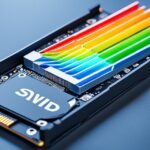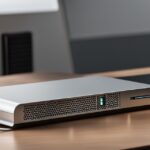Table of Contents
Understanding a hard drive’s power consumption is key. It’s crucial for energy efficiency and system performance. With the increase in computing tasks, the energy used by storage devices needs focus. This is because these drives add to modern technology’s energy footprint.
Hard drives use different amounts of energy when idle and active. This shows the importance of smart optimisation strategies. An external hard drive, for example, uses between 1 and 10 watts. This leads to an average of 24 watt-hours per day if it stays plugged in. That means around 720 watt-hours in a month1. By knowing these numbers, users can make better choices. This helps them save on costs and reduce environmental harm.
Key Takeaways
- Power consumption of hard drives varies based on type and usage.
- External hard drives typically consume between 1 to 10 watts.
- Understanding energy usage can lead to cost savings on electricity bills.
- Optimising power consumption enhances storage device efficiency.
- Small changes can yield significant reductions in energy costs.
- The impact of hard drive energy usage affects overall system efficiency.
Introduction to Hard Drive Power Consumption
Knowing how much energy hard drives use is key in today’s computers. Both regular and solid-state drives impact a computer’s power. A small, 2.5″ hard drive uses about 0.7 to 3 watts when it works. A larger, 3.5″ drive needs 6.5 to 9 watts. These numbers show why it’s important to think about energy efficiency when designing and using them.
SSDs use less energy, usually 1 to 3 watts during active use and under 1 watt when idle2. New tech has made drives like the WD Red NAS work with only 2 to 6 watts3. Comparing different drives shows that an average 6TB HDD uses 6 to 10 watts2. Choosing efficient drives is key for better energy management.
To improve both performance and energy saving, looking at hard drive power use is essential. Knowing how much energy different drives use helps pick the right one. It also points out how you can save on electricity bills. This is important for both home and business users.
Typical Power Usage of Different Hard Drives
When looking at hard drive power use, it’s key to understand the size difference. 2.5 inch and 3.5 inch hard drives use power differently. This affects whether people choose portable or desktop options.
Understanding 2.5″ vs 3.5″ Hard Disk Drives
2.5 inch hard drives use 0.7 to 3 W, great for laptops. 3.5 inch drives need more power, from 6.5 to 9 W. That’s something to think about for desktops. Knowing this helps choose the right hard drive, while also thinking about energy costs and what fits best.
This is very important in comparing hard drives.
Comparing HDD and SSD Power Consumption
SSDs use between 0.6 to 2.8 W, offering better efficiency. Their low power use is comparable to 2.5 inch hard drives but they outperform 3.5 inch versions. This is crucial for getting the best out of your system and saving energy. SSDs are especially worth considering in today’s computers.
| Drive Type | Power Consumption (W) | Typical Storage Capacity |
|---|---|---|
| 2.5 inch HDD | 0.7 – 3 | Up to 18 TB |
| 3.5 inch HDD | 6.5 – 9 | Up to 18 TB |
| SSD | 0.6 – 2.8 | Typically 128 GB to 30.72 TB |
Knowing these differences helps people make smart picks. You might want the lesser power use of 2.5 inch drives or the speed of SSDs. Each choice has its benefits for different needs. As hard drive tech evolves, staying updated is crucial for making the best decisions456.
How Much Power Does a Hard Drive Use
Knowing how much power hard drives use is key for anyone. The average power use of hard drives can really change. This depends on the drive type and if it’s being used or not. A 2TB Western Digital hard drive usually uses about 6-7 watts when working. But, when it’s not being used, it only needs about 2-3 watts7. Newer hard drives are getting better at using less power. This is because people now want devices that are kinder to the environment7.
Average Power Ratings
The power needed by hard drives can differ a lot. For example, external hard drives need between 1 watt to 10 watts, based on how they are used1. A 2TB Western Digital portable drive uses 2-4 watts during regular use. This might go up a bit when moving data around7. When starting up, they might need up to 30 watts, especially the fast ones. Doing a power consumption analysis helps understand your power needs better.
Factors Influencing Power Consumption
Several things can change how much power a hard drive uses. These include how much it’s working, how old it is, and the drive model. New drives often have smart features to save power. They can switch to a low-power state when not doing much7. Also, external drives with features like auto shut-off save even more power1. If left on all day, an external hard drive can use about 24 watt-hours in a day. Over a year, this could cost around $10.51, depending on energy prices1.
Impact of Power Consumption on System Efficiency
Knowing how power use affects system performance is key for both people and organisations. It’s important to work out power needs carefully when setting up or updating computers. This helps keep things stable and boosts performance overall. By doing so, you make sure the power supply matches the hardware needs. This prevents problems from not having enough power.
Importance of Calculating Total Power Needs
It’s vital to figure out how much power your system will need right from the start. Without this, you might end up with inefficient setups or sudden power cuts. Given that parts like hard drives vary in power use, knowing their needs is key. For instance, a WD 8TB HDD uses 5-8 watts in general but can spike to 14.4 watts depending on how busy it is8. Awareness like this helps in making smart energy choices.
Effects on Electricity Bills
How much power you use directly affects your electricity bill. With the price of energy on the rise, even minor savings can make a big difference. By choosing the right hardware, you can use power more efficiently. This not only improves your system but also reduces your electricity costs. It leads to a more eco-friendly tech setup.
FAQ
What is the significance of understanding hard drive power consumption?
Understanding hard drive power use is key for better energy use and system performance. It lets users know the energy their devices use. This knowledge aids in choosing drives and upgrading systems wisely.
How does power consumption differ between 2.5″ and 3.5″ hard drives?
2.5″ drives use about 0.7 to 3 W, much less than the 6.5 to 9 W used by 3.5″ drives. This is important for picking drives for laptops or desktops. It affects how much energy the device uses.
How do SSDs compare to HDDs in terms of power consumption?
SSDs use between 0.6 to 2.8 W, making them more efficient than 3.5″ HDDs. They have similar idle power to 2.5″ HDDs but perform better when active. SSDs are a good choice for saving energy.
What should I know about the average power ratings of hard drives?
Typical hard drives consume 3-6 W when idle. During regular use, high-speed ones may need 8-10 W and demand up to 30 W to start spinning. Knowing these ratings helps in planning system power use.
What factors influence the power consumption of hard drives?
Different elements affect how much power drives use. Workload, speed, how often they’re idle, and their age play a role. Understanding these can lead to a precise estimate of power use.
How does hard drive power consumption affect overall system efficiency?
Power use by hard drives has a big impact on system efficiency. Getting the total power requirement right is essential. This avoids overloading and keeps the system stable, crucial for new builds or upgrades.
What are the financial implications of hard drive power consumption?
Higher power use by hard drives can lead to bigger electricity bills. Choosing the right storage device is important to keep costs down. This consideration helps manage expenses better.
Source Links
- https://www.slashplan.com/external-hard-drive-energy-calculator-cost-and-kwh-usage/ – External Hard Drive Energy Calculator (Cost and kWh Usage)
- https://www.genuinemodules.com/how-many-watts-is-a-6tb-hard-drive_a5818 – How many watts is a 6tb hard drive?
- https://www.genuinemodules.com/how-much-power-does-a-wd-red-nas-hard-drive-use_a5947 – How much power does a wd red nas hard drive use?
- https://arstechnica.com/civis/threads/how-much-power-would-12-hard-drives-need.78339/ – How much power would 12 hard drives need?
- https://www.ibm.com/think/topics/hard-disk-drive-vs-solid-state-drive – Hard Disk Drive (HDD) vs. Solid State Drive (SSD) | IBM
- https://en.wikipedia.org/wiki/Hard_disk_drive – Hard disk drive
- https://www.genuinemodules.com/how-much-power-does-western-digital-2tb-use_a9246 – How much power does western digital 2tb use?
- https://www.infoq.com/articles/power-consumption-servers/ – The Problem of Power Consumption in Servers








